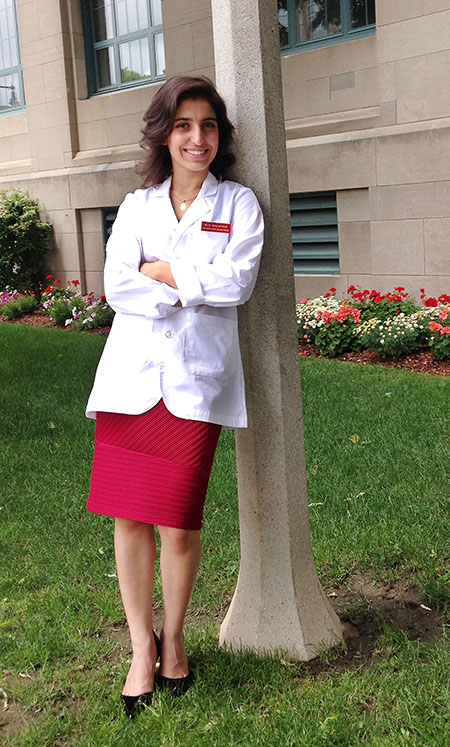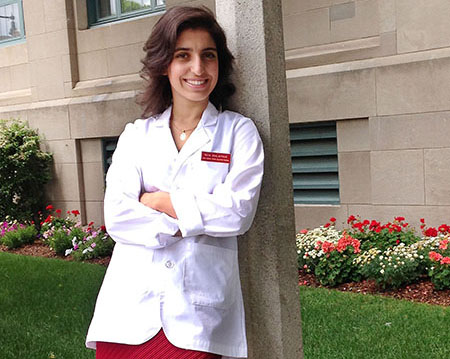By Rachel Anna Neff, Ph.D.
UTEP News Service
Small actions reverberate and amplify, like ripples in a pond after a rock has been tossed in. Mentors can have this same positive effect in the life and career of their mentees. Roya Edalatpour’s experience with her mentors at The University of Texas at El Paso is proof of how the dedicated professors and staff of the University have a major impact on students’ lives.
Edalatpour, a rising junior at UTEP, began a mentoring relationship with Martine Ceberio, Ph.D., an associate professor of computer science at UTEP, while she was still in high school as part of the College of Engineering’s Nexus shadowing program.

Ceberio knows how critical mentorship can be, especially for young women interested in fields like computer science, where fewer than one out of every five bachelor’s degree recipients are women.
“I bring young women from high school to my lab to show them what computer science is like so they can see themselves as computer scientists,” Ceberio said. “If they want to continue the mentoring relationship, I’m more than happy to continue to follow them closely. In any case, I touch base with them regularly and keep involved with their projects, even if they decide not to pursue a degree or career in computer science.”
Through Ceberio’s tutelage and encouragement, Edalatpour became more interested in STEM (science, technology, engineering and mathematics) fields. During her time as a Nexus participant, Edalatpour worked on creating a robot capable of solving a Rubik’s Cube.
Although her initial interest in STEM started with computer science, over time Edalatpour’s focus shifted to other areas. She decided to major in electrical engineering, but found her true passion in medicine and the pursuit of researching medical instrumentation – instruments used to diagnose, prevent or treat disease and other conditions.
With a goal to earn a dual degree, a Ph.D. in biomedical engineering and an M.D. from Boston University School of Medicine, Edalatpour applied to and was accepted into the Early Medical School Selection Program (EMSSP). UTEP is a member of the consortium with Boston University’s program that grants provisional acceptance to the Boston University School of Medicine and has students take summer classes and their senior year undergraduate coursework at Boston University.
She learned about the program through UTEP’s Medical Professions Institute, a pre-professional advising office on campus dedicated to helping students interested in attending medical, dental, veterinary, optometry or physician assistant school. Mary C.D. Wells, the intitute’s director, helped mentor Edalatpour and supported her application to the EMSSP.
From this experience, Edalatpour connected to another UTEP mentor, Homer Nazeran, Ph.D., a professor of electrical and computer engineering and the newly established Biomedical Engineering Graduate Degree. Nazeran also actively participates in UTEP’s Office of Undergraduate Studies Faculty-Student Mentorship Program (FSMP).
“Mentoring is about building and establishing a strong pillar of support for our students,” Nazeran said. “You can create successful researchers and scholars, and nurture the development of great human beings. By going the extra mile through mentoring, we are able to guide our students as they realize their academic dreams and fulfill their future potential.”
As part of the Campus Office of Undergraduate Research Initiatives (COURI) and Provost’s Summer Research Assistant Program, Edalatpour joined Nazeran’s biomedical engineering research team in the summer of 2012 to work with him on his pulmonary medicine research project.
There, she and other students used research data collected as part a five-year National Institutes of Health-supported study called “UTEP-UNM HSC AARCH Program on Border Asthma” to analyze the sensitivity and specificity of a pilot data set in El Paso children to confirm the effectiveness of impulse oscillometry compared to standard spirometry.
Impulse oscillometry uses brief pulses of sound waves generated by a device that assesses the patient’s breathing during normal respiration by measuring air pressure and flow at the mouth. This information is then fed to a computer program to estimate if the lungs have any difficulties moving air and evaluate how the lungs function, especially in the small airways. Spirometry measures how much air someone can inhale and exhale and requires extreme breathing maneuvers, which are very difficult to perform, especially for asthmatic children.
Nazeran’s pioneering research uses impulse oscillometric-based models of the human respiratory system developed and validated at UTEP to detect changes in the small airways due to illness that may not be easily determined through standard spirometry.
The paper resulting from this summer project was published as part of a conference proceeding in which Edalatpour was listed as a co-author.
Edalatpour has continued to work in Nazeran’s lab, and this summer her next project with him is to help summarize decades of impulse oscillometry data regarding the lung function behavior in Hispanic and non-Hispanic children by developing respiratory reference equations. The summary’s clinical and research value and is being prepared for publication as a journal article with Edalatpour as a co-author.
As if spending six weeks of her summer in Massachusetts and working on a second project with Nazeran were not enough, Edalatpour also has an eight-week internship with ExxonMobil Research and Engineering in Fairfax, Va., where she will work as an instrumentation engineer – someone who specializes in designing and configuring automated systems and integrating sensors with recorders, transmitters and other sensing equipment.
In the background of this summer’s three life-changing experiences is Edalatpour’s desire to give other students like herself the opportunity to have their interests cultivated by caring mentors.
Drawing on the network of young women in information technology she met as a result of her high school mentorship with Ceberio, last February Edalatpour began to assist the co-founders of Magikstra with their idea to connect middle and high school students with professors and professionals.
Scheduled to launch in fall 2014, Magikstra team members from around the U.S. have been working to build a secure and polished website capable of delivering a powerful and dynamic platform. The site will connect mentees with college professors and professionals in the sciences and humanities who can provide career advice, internships and job opportunities.
Edalatpour, the only member of the team from Texas, works on outreach and marketing. Magikstra has been a semi-finalist and finalist for several startup grants, and the team hopes to secure a grant to cover its operating costs.
“It’s been great collaborating with the group,” Edalatpour said. “We’re taking the spirit of innovation and turning it into something that will help young students discover their full potential. Mentorships are the best way to gain exposure to what you’re going to study in college and Magikstra will provide that connection.”
“I truly believe what Magikstra is doing will help young people discover their career paths, like I was able to through mentorship and guidance from the faculty at UTEP and the medical professionals in El Paso,” she continued.
The importance of engaging undergraduate students in research and mentorship opportunities is not lost on Richard Schoephoerster, Ph.D. dean of the College of Engineering.
“The faculty in the College of Engineering is committed to the success of our students, and it shows in the huge investment of time and energy they put into working with students and guiding them through a degree at UTEP, and in helping the students make appropriate decisions for their future career,” he said. “Roya is an outstanding example of a student taking advantage of those opportunities provided by faculty guidance.”
